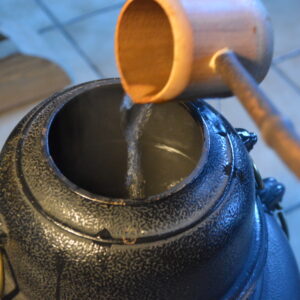Description
To book our online workshops, just contact us in advance to book the time.
History shows that there was already a tax on tea in the year 221 v. Chr. during the Qin Dynasty. Tea was then primarily used as a medicine. During the Tang Dynasty (618-907) it was increasingly drunk as tea beverages using the Fired Tea Method 煎茶法 at the imperial court and thus introduced into the upper class, which had been shown on the painting “Tang Palace Musicians 唐人宫乐图”. During this time, monks in Buddhist monasteries began drinking tea during their often long hours meditations in order to stay awake. It’s also true that the monks every morning drank tea and flushed their mouth as they had no toothbrushes, since the tea had a purifying and refreshing effect. This behavior is said to have been first introduced in the Yang Ling Monastery on Mount. Tai and have spread from there to other monasteries. After some time, the monks began to cultivate tea, the world’s first book on tea was written <the the classic of tea 茶经> by Lu Yu 陆羽 (733—804), who grew up as an orphan in a Buddhist monastery, his nickname “The Saint of Tea”.
In the Tang period, tea was boiled along with the water until the water took the right color, wherein fired and grinded tea was used. Since this tea liquid was added a pinch of salt, this method is also called “school of salted Pulvertees” Fired Tea Method 煎茶法 [jiān chá fǎ].
An Tea Method 庵茶法 [ān chá fǎ], use some tea powder in a tea jar and brew it with boiling water, Tang people thought that using this kind of tea method tea was not fully cooked and could only be drunk but not eaten, so they called it half-cooked tea.
Based on historical data, there are 67 tea producing areas in Tang Dynasty, 8 tea producing areas mentioned in Lu Yu’s <Tea Classic 茶经>, 43 states (counties), which are equivalent to 13 provinces today. In Tang Dynasty, there were more than 50 kinds of famous tea, most of which were steamed green cake tea, and a small amount of loose tea, including green tea and yellow tea. At that time, Guzhu Purple Bamboo Shoot tea from Wuyue (Jiangsu and Zhejiang) and Mengshan Purple Bamboo Shoot tea from Xishu (Sichuan) were the most popular products of the Tang emperor. Tang tribute tea producing house is located in Hutou Cliff on the side of Guzhu mountain, Changxing County, Zhejiang Province, which was founded in 770. It is the place to supervise the production of tribute tea Guzhu tea in Tang Dynasty, it is also the first tea processing factory in Chinese history. Read More
There are two representative methods of tea cooking in Tang Dynasty: one is the method of fried tea represented by Lu Yu, and the other is the method of whisked tea elaborated by Su Lin in <sixteen soup>. In addition, there are some other methods between tea fried and tea whisked. With the different methods of cooking tea, the required utensils are not the same. Generally speaking, the tea sets of Tang Dynasty can be roughly divided into two categories: one is the 28 kinds of tea drinking utensils listed by Lu Yu in the book of tea, which are folk tea drinking utensils including those used by local officials and scholars; the other is the gold and silver, secret color porcelain and glazed tea utensils of Tang Dynasty unearthed from the underground palace of Famen Temple in Shaanxi, which are royal tea drinking utensils.

































